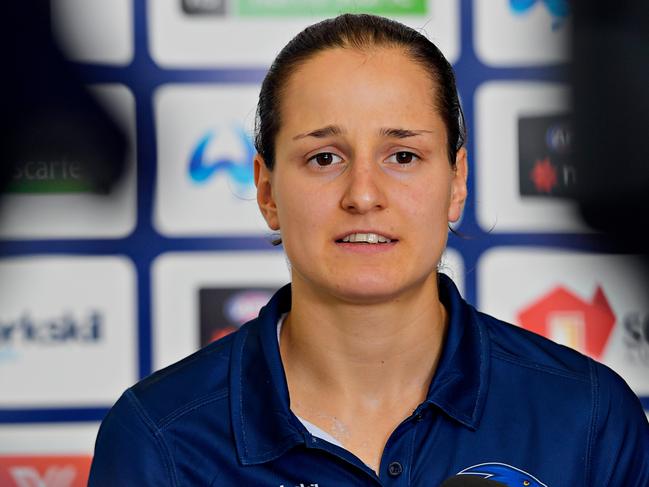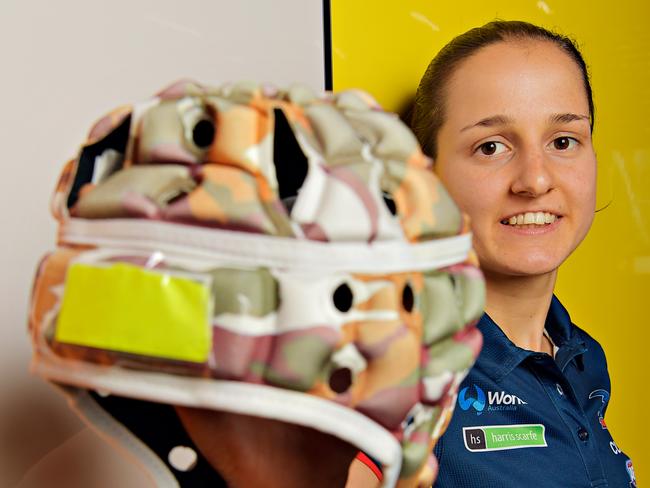Former AFLW player Heather Anderson the first female athlete in Australia to be diagnosed with CTE
The doctor who found CTE in Heather Anderson’s brain following her death last year, has made a shock prediction about AFLW based on the exploding popularity of contact sport.
AFLW
Don't miss out on the headlines from AFLW. Followed categories will be added to My News.
The doctor who found CTE in the brain of former Adelaide Crows AFLW player Heather Anderson says this is just “the tip of the iceberg” for female athletes.
The 2017 Crows AFLW premiership player died in November aged just 28.
Her death in Perth is subject to an ongoing coronial investigation, but it is suspected she died by suicide.
After her death, the brain of the former army medic was donated to the Australian Sports Brain Bank.
It was examined and was found that Anderson had low level chronic traumatic encephalopathy - a degenerative brain disease - the first confirmed case in a female professional athlete in the world.
Dr Michael Buckland, the director of the Brain Bank, said with the increase of more females playing contact sport this was just the beginning.

“It is definitely the tip of the iceberg,” he told this masthead.
“I think everyone had been expecting someone to find it sooner or later because of the rise of female participation in contact sports.
“Clearly in Australia with the formation of the AFLW and the surge of interest from females in playing, it was almost bound to happen.”
Anderson played eight games for the Crows in 2017, the first year of the AFLW, before she was delisted in 2018 after shoulder injuries.
It is understood that she did not suffer any concussion while she played at the Crows.
Anderson did play rugby league when she was growing up in Canberra, before making the shift to football.
She became known for wearing a pink helmet when playing games when her mother insisted that she wear one due to the risk of concussions.
Dr Buckland said as far as he was aware the evidence to date said that headgear would not help.
“The evidence today indicates that the number of concussions you get does not correlate particularly well with your risk of CTE,” he said.
“What does correlate with CTE is the number of years that you are playing a contact sport for.

“It (headgear) is good for skull and scalp injuries but the brain is still rattling around inside the skull and giving you these concussions and sub concussions.”
Anderson’s father Brian said he was still processing the diagnosis of CTE in his daughter.
“It was a surprise, but not a surprise,” he told the ABC.
“And I didn’t really go out of my way to discuss it with people. And I think now that this report has been published, I’m sort of trying to think about how it might play out for female sportspeople everywhere.”
CTE has been found in the brains of former VFL and AFL stars Graham ‘Polly’ Farmer, Danny Frawley and Shane Tuck.
The AFL is facing multiple concussion lawsuits and two class actions relating to concussion issues in former players.
On Tuesday the league encouraged players to consider donating their brains to further research in the area.
“The AFL extends its deepest sympathies to the Anderson family and commends Heather’s loving family for donating her brain to scientific research which will help in providing better understanding of the disease and its impact in the future,” a spokesman said.
“Heather was an outstanding athlete who played AFLW and other sports and also served our country as a member of the Australian Defence Forces.
“We continue to encourage football players to consider donating their brains to further research in this area and reiterate that the health and safety of ALL players is the AFL’s upmost priority.
“We continue to learn about the impact of concussion and head trauma including through various research projects and make the informed adjustments to rules and protocols to ensure the game remains accessible and as safe as possible for everyone.”
Dr Buckland said the Brain Bank had examined 60 brains and CTE had been found in 50 per cent of them.
This included multiple in brains of people in their 20s and 30s.
Adelaide was contacted for comment.





